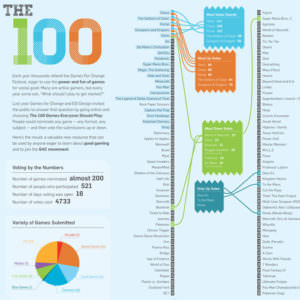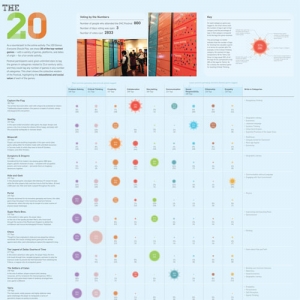The 100 Games Everyone Should Play
Posted June 13, 2013
(Click on the infographics above to enlarge and explore).
Each year hundreds attend the Games For Change Festival (G4C), eager to use the power and fun of games for social good. Many are active gamers, but every year some ask, “What should I play to get started?” Because before you can design a game that promotes social change, you need to understand what makes a game good fun, engaging, effective, and shareable.
So last year, Games for Change and ESI Design invited the public to answer that question by going online and choosing The 100 Games Everyone Should Play. People could nominate any game — any format, any subject — and then vote the submissions up or down. It was an opportunity to champion old favorites, find new ones, and help create a valuable resource for people to learn the basics of good gaming and join the G4C movement. Over 500 people participated, nominating almost 200 games and casting over 4700 votes.
You can check out full information about The 100 in the accompanying infographic, but here are the top 20:
- Chess
- The Settlers of Catan
- Portal
- Dungeons and Dragons
- Tetris
- Go
- Sid Meier’s Civilization
- SimCity
- Pandemic
- Super Mario Brothers
- Magic: The Gathering
- Hide-and-Seek
- Minecraft
- Pac-Man
- Carcassonne
- The Legend of Zelda: Ocarina of Time
- Rock Paper Scissors
- Capture the Flag
- Grim Fandango
- Katamari Damacy
There were some interesting themes that emerged from the voting:
Game Format: People nominated games in multiple formats: live action, board game, card game, dice game, arcade, PC, console, and mobile. And it’s fascinating to see that The 100 are almost evenly split between digital games (52) and non-digital (48), with PC and board games perfectly tied at 24 each, which shows that learning about good gaming doesn’t need to be restricted by technology (or the lack of it).
Date of Origin: As might be expected, recent games dominate the list, with over one third released since 2000. But 15 of the top 20 games are older than that, in some cases much older, such as Chess, which dates back to the 6th century, and Go, a game that’s over 2000 years old. Many of the “classics” you remember from childhood — Mastermind, Pong, Uno, Tetris, Space Invaders, Dungeons & Dragons — also made The 100, demonstrating that a really good game has staying power.
Popularity: Some games received a lot more votes than others, demonstrating which games people have played most often and/or have the strongest opinions about. There were mostly up votes for some games, such as Chess, Portal, Settlers of Catan, and Dungeons & Dragons. And mostly down votes for others, such as World of Warcraft, Bioshock, Muggle Quidditch, and Dr. Mario.
Controversy: Some games inspired a real divergence of opinion. Tetris, for example, received among the largest numbers of BOTH up and down votes. Other games — such as FreeRice, League of Legends, and Musical Chairs — got exactly equal numbers of up and down votes, which effectively cancelled each other out.
But knowing which games to play isn’t enough. You also need to know WHY to play them.
When people nominated games for The 100, they also described why they were good games, with rationales as varied as the games themselves — simplicity, complexity, great storytelling, historic role in game design, educational value, artistic value, fun, elegance, longevity, and many more. But why did the public, the people who voted for the games, think they were good?
To answer this new question, ESI Design created The 20, an onsite activity for the 9th G4C Festival that was a complement to the online activity. We chose 20 of the top-ranked games from The 100 — with a variety of genres, platforms, and dates of origin — and asked Festival participants to tell us why they were valuable. We gave them an unlimited number of stars to tag the games in categories related to 21st-century skills, as well as to G4C’s mission: problem solving, critical thinking, creativity, collaboration, storytelling, communication, social responsibility, citizenship, and empathy. People could tag any number of games in any number of categories. They could also write in other values (or star the values that other people had added). By the end of the three-day Festival, which was attended by 800 people, the games had been tagged with over 2800 stars.
You can check out the collective wisdom of the Festival in The 20 infographic, which highlights the educational and social value of each of the games.
For each category a game was tagged in, the chart shows both the number of stars it got in that category and the percentage of stars in that category compared to all the stars the game received. The percentage is a better indicator than the number of stars for showing how valuable a game is in terms of a certain skill. For example, in the Critical Thinking category, Go received 44 stars compared to the 46 that Tetris received, but those 44 stars equal 56% of all the stars for Go (compared to only 28% of the stars for Tetris). So Festival attendees think that Critical Thinking is a more prominent element of Go than of Tetris.
The top game (percentage of tags) for each category is:
- Problem solving: Pong (40%)
- Critical thinking: Go (56%)
- Creativity: Minecraft (34%)
- Collaboration: Capture the Flag (33%)
- Storytelling: Grim Fandango (45%)
- Communication: The Settlers of Catan (28%)
- Social responsibility: SimCity (23%)
- Citizenship: Sid Meier’s Civilization (23%)
- Empathy: Hide-and-Seek (15%)
How people starred the games revealed several more trends:
Category distribution: All games were tagged in multiple categories, but how evenly the stars were distributed among the categories depended on the game. Some games, like SimCity, were seen as good at teaching many skills, such as creativity, social responsibility, and citizenship. But other games were seen as being good at teaching primarily one skill only, such as Go (critical thinking) or Pong (problem solving).
Dominant skills: Two categories — critical thinking and problem solving — were tagged for every single game, which suggests that these are fundamental elements of good games. It may be obvious, but it’s still true.
Neglected skills: Other categories — social responsibility, citizenship, empathy — were tagged in the fewest games. This suggests not only that they are seen as less significant elements of good games, but also that they may be less common gameplay elements overall. This is a point of particular interest to the G4C movement, because social responsibility, citizenship, and empathy are all necessary components of social change.
The results of The 20 show a clear need to develop not only games that promote social change, but also games that help develop the skills that make social change possible.
So where do we go from here? Please leave your comments below!




Join The Conversation